Earlier in September, Southern California artist Larime Taylor launched a Kickstarter for his graphic novel, Dark Zoey. The project is notable not only because it’s a female-centric plot with a diverse cast of characters, but also because of Taylor’s personal story as an artist living with arthrogryposis, a rare congenital disorder that has left him without the use of his hands or feet. With a modest goal of $1,500, Taylor’s Kickstarter went viral, thanks to support from big-name comics creators, and ended up raising nearly ten thousand dollars. About two months later, his backers finally had the opportunity to read the digital version of the first issue of his tale, now known as A Voice in the Dark. A week after digital release, I spoke with Taylor about his inspiration and the process of making his project a reality.
For any readers that aren’t familiar with the story of A Voice in the Dark, could you give us a summary of what it’s about?
The protagonist, Zoey has been struggling all her life with urges and her fascination with death. After eighteen years of dealing with that, she ended up going from just thinking about killing and even skirting the line of almost going to do it, to finally doing it. Now it’s starting to blur the line of reality for her, and she’s concerned that she’s starting to lose her grip. She’s worried that she’s going to start killing indiscriminately.
I know that pretty much all creative people hate this question: where did the idea come from?
“So I’m gonna ask it!”
It’s not a bad question. It was originally going to be a webcomic I was doing that was going to be a very over-the-top: campy, parody, satire of the horror genre. In horror movies, it’s the ethnic character that always dies first. So the first thing I need to do is make sure that’s the main character and they don’t die first. From there it was all just turning archetypes on their heads, and really kind of taking the piss out of the genre.
I’ve toned it down a lot, and made it a lot more serious now, but it still has some of the quirkier elements and the callbacks to things that I grew up with that influenced me. I grew up in the late eighties, early nineties, so I grew up on movies like Heathers and Pump Up The Volume, and early college radio and alternative music. A lot of that is really influencing the story and influencing what I’m doing.
That idea, where you were trying to turn genre conventions on their heads, is that where you got the inkling to not have just a protagonist of color, but a female protagonist of color?
Oh yeah, exactly. It was, “It’s gonna be a female protagonist of color who is the sole survivor”, and then I was like, “What if she is the killer?” I was kind of being a bit campy with that, but then I decided, no, there was actually an interesting story here I could play with.
I’m not doing nearly as many of the tongue in-cheek things, though some of it survives. The campus radio station, which is K.I.L.L. and the school originally was called Slaughter University, but now it’s just the nickname: the college was founded by a silver screen starlet whose screen name was Amelia Blair, but was named Amy Slaughter at birth. They call it Slaughter University because of that and because the city that it’s in has an unusually high serial killer count. There are still those campy elements to it, but they’re not as right on the surface. It’s more realistic, there’s more explanation behind it. It’s not as cheesy as it once was.
Did you end up reading a lot of bloody true crime to put this together, or was it mostly built from tropes and archetypes?
It’s mostly tropes and archetypes. I personally have always had an interest in that, so there is some of me in Zoey in that regard. She’s well-versed in the methodology of it. She knows, for example, that the two biggest things that get most serial killers in trouble are the ritual and the trophies. So she goes out of her way to do neither.
I’ve had a few people ask me, “Isn’t it kind of stupid that she’s keeping a diary?” and I’m prepared for that. One of the things that is going to happen early on is that she will make a comment that will let the reader know she doesn’t keep these diaries like the dude from Se7en, where he had a house full of them, “Here’s everything I’ve ever done with my life!” She actually burns each one as soon as it’s full, so she doesn’t leave them behind. And she always keeps them on her person, so she doesn’t leave them lying around for her roommates to find, and she doesn’t have a collection of them on the wall.
Mostly a lot of it is more tropes and playing with the genre, and trying to take those tropes and those absurdities and mine them for something interesting, and what do those things really have to say about us. And so her roommates, for example, are all archetypes. We’ve only seen one so far in issue one: Ash, the goth punk type, is instead of the antisocial loner with an attitude is actually like the big sister of the four of them. So I’m really trying to take those stereotypes and turn them upside down.
It seems like even in just the few characters that we’ve met, that it isn’t the White majority that we usually see in comics. I was wondering where that came from, because even if you’re only going from horror tropes, you usually only have the one person of color who dies before the end of the third reel, and that’s that.
Right, you have maybe the one token Black character, and the one Hispanic character and then if you’re lucky you get an Asian.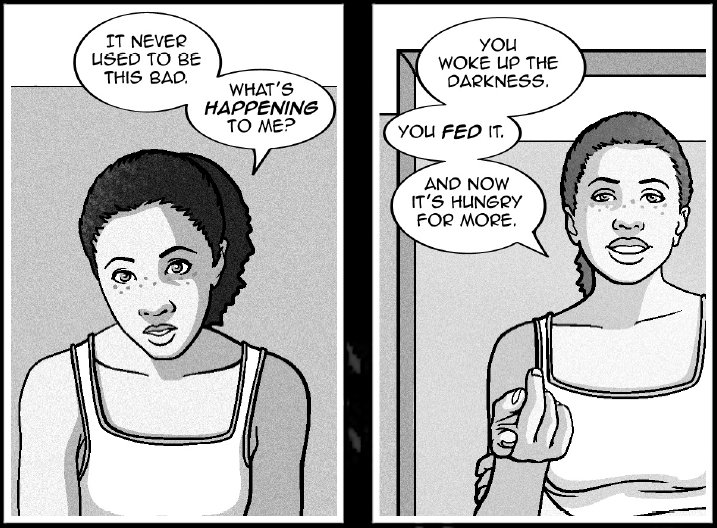
And you never get a gay character.
And if you do, they’re always a horrible cliche.
I’m from Arizona and California, so I’ve been surrounded by not quite as White of a population: largely Hispanic, but also to varying degrees Black and Asian. And so, I’m wanting to – since I know there is such an absence of that in comics and popular media in general – I was wanting to try and make a more diverse comic as a point. I’ve even had a few people tell me that they think I have too much diversity in it, it’s not realistic. That’s when I hit my head against the wall.
I’ve always had friends of different ethnicities, different sexualities. My best friend in high school, before he graduated and moved off, was an openly-gay Hispanic boy. He was the only openly gay kid at our school, and this was back in the early nineties, when that was risky. He got a lot of shit for it, and he was one of my good friends. Seven kind of comes from that. A lot of the characters are bits and pieces of people I knew, and in some cases, pieces of me.
It’s the relationship with her adopted sister Seven that ultimately gives Zoey a reason or an excuse – it’s difficult to say which it is in the first issue – to commit her first murder.
That’s part of what I want. I want the reader to have to decide for themselves. Was it a justifiable reason? On the one hand, this girl lead to some really bad things happening to Seven that had some really heavy consequences. On the other hand, shit happens, and this is high school and most people do survive it and grow up with their scars and move on.
Being in a wheelchair, I got all sorts of shit and didn’t end up murdering anybody. Partly because I wear a seatbelt. (That’s was a joke, but anyway.)
I want it to be a grey area. There’s a reason. How good of a reason it is, is going to be up to the individual reader. I want for Zoey to make mistakes, and I want to see if I’ve made the reader invested in the character enough. While the mistake maybe makes them uncomfortable, are they willing to ride it out and see where it goes? Or does it completely turn them off? Hopefully it doesn’t.
Could you walk us through what your process is? Following the updates on your Kickstarter page, it does give the impression that, boy, you work fast.
I do. I’m finding out I work pretty fast for what the industry standard is. Part of it is my method, part of it is, I come from a caricature artist background, where you draw quickly. As a caricature artist, you’re getting paid by the caricature. You’ve got to get as many people done fast as you can, but still have it look good. So speed-drawing is something that I’m okay at.
What I do, to start, is obviously write the script, get the edits, work that all out. Because all of my life I’ve not been able to model myself, you know, I can’t use my own hands to see how a hand would look doing this, or what your arm does when you bend it this way. I
draw with a pen in my mouth, so I can’t look up at something, then down at the paper as I’m drawing at the same time. Now that I have a digital tablet screen that I draw directly on, I’m able to photo-reference.
I can already hear some people screaming “Oh, you’re a tracer!” Um, no, not exactly. If you look at, where I’ve made a collage version of a page, and then you look at the finished page, they’re really nothing alike. For example, one of the girls that was posing for me as Zoey for some of the pages has a medical condition that means she’s really, really frail. She’s like six-foot-one and really, really thin. When I was drawing pages where she was standing in for Zoey, I would have to do a lot of work because Zoey’s got a much more athletic build.
I would have to add a lot of definition and build up all of that on top of what I had to work with.
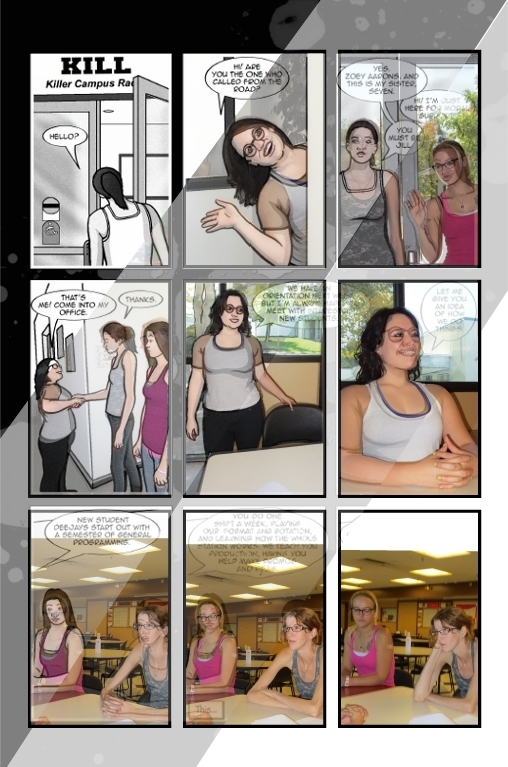
I’m not just sitting there cookie-cuttering the lines around my people. Their faces are nothing like the people that I’m drawing – their hair, their clothes, the backgrounds. Almost the entire book was shot at the cafeteria at the local community college and I used that for several different scenes that look nothing like a cafeteria at a community college.
I take the script and from the script, page by page, I shoot the poses that I will need, so that I have the anatomy to reference when I need it. It also allows me to lay the photos out on a page the way the panels will be, so that I can letter it. That allows me, before I even draw a panel, to look at what I’m planning to do with the lettering that I’ve written and see, “Oh, I wrote way too much in that panel,” or “Hey, I’ve got a lot of room here, I could move that.” I play with the layout a bit then, and then I got through and actually start drawing the pages, and then drop the art into the already-existing lettering.
Is this your first work in the graphic novel form?
This is my first solo attempt. I have written some in the past. The guy who did my title design, Duncan Eagleson was the penciller, and then my wife was coloring directly over the raw pencils. We had a publishing deal for it, but my wife’s medical condition got so bad that she couldn’t really do the coloring. We couldn’t afford his page rate, because he actually is an established professional. We couldn’t afford to keep him, and that project fell apart.
That’s why this one I’m doing it all myself. Putting it all on my shoulders, I don’t have to worry, “Can I afford the colorist? Can I afford the inker? Is my wife healthy enough to do this?” I can just do it myself and be a one-man team, so that if it’s late, it’s because of me. If it works, it’s because of me. And, if it doesn’t, it’s because of me.
I heard about this project through Gail Simone’s Tumblr, but you also got attention from Neil Gaiman, Kurt Busiek, Jamal Igle, Warren Ellis, basically a murderer’s row of modern comics.
Right, they all did retweets, but Gail’s the one that really blew it wide open for it. She’d mentioned it on her Twitter once or twice, but I found out very fast on the last day that Tumblr kicks Twitter’s ass when it comes to making something go viral. I got five to ten from this one, fifteen from that one, you know, the bigger names did bigger amounts. The one that gave me over a hundred of the backer referrals, easily, was Tumblr on the very last day.
What brought you to Kickstarter? And why do you think it exploded like it did?
Well, a couple of things. First of all, I’ve done Kickstarter before. I had a novella series I was writing, actual prose fiction rather than graphic fiction. I was doing a novella horror series, called Hellwatch, that I did a small Kickstarter for. I had major computer failures, and was only able to complete one of the two novellas. I had less than a hundred backers, and they were all people I knew, so I transferred them all over, unofficially, to the new Kickstarter. I told them, “Since I only got you half of the reward, you only got one of the two novellas, because I lost all of my notes and everything, I’d give them you or better rewards for this new project”, and everyone to a person said, “Sure, okay, great.”
I wanted to do something serialized… so I thought, I can pick up the art again, and if I can just train myself to be good enough as an artist, I can do my own comic book. Just do it myself, make myself be a better artist. I don’t like drawing buildings. I don’t like drawing cars. I don’t like drawing this, that and the other. I’ll make myself do it anyway. I’m finding that I’m actually getting decent at it. I just kind of went through this artist bootcamp.
I decided that I would use the Kickstarter to do a single issue that I would use as my submission for Image and all the other publishers. They say that they want a minimum of five-to-six pages, and the more you can send, the better. I’m thinking, what if I give them a completed issue? They can see the beginning, middle and end, how I storytell. They can get continuity and see an actual, finished product of what they would be getting.
The funding would go a little bit to help me live while I’m doing this, and the majority of the money would go towards printing a final, print copy of it that everybody that donated over the minimum would get. It was going good from just the different people that you mentioned on Twitter and such. Gail had tweeted it a couple of times, and I’ve known her for years. My initial goal as I said was $1,500. I said, okay, if I can make it to $2,000 I’ll add some extra pages: instead of making an 18-page, I’d make a 24-page. I hit that in like the first week.
I was just about to crawl across the finish line on the last day and make $5,000, which I didn’t think I was going to make, when the whole Tumblr thing exploded. Gail Simone probably has one of the most proactive, vocal and internet-connected fanbases in comics right now. Of all the people in comics to really champion your cause, Gail’s a good one. I think because she approached it from the fact the characters are diverse, and I’m a disabled creator, and did it through Tumblr, it ended up hitting a lot of different paths. You know, the people that are interested in diversity in comics got it on a persons of color Tumblr that exploded, and then people that were interested in the human interest element of me as a disabled artist picked up on it.
Then, the fact that I was giving you a copy of the comic, digitally, for a buck – and I have yet to see any of the other comic books on Kickstarter do that – I think also made it attractive. A lot of people came in for the comic for a buck and ended up thinking this looks interesting and pledged more.
Frankly I’m surprised that more comics Kickstarters don’t offer a digital version, especially at such a low threshold.
I think part of it is the backlash to piracy. People are afraid that a digital copy out there means that everybody’s just going to pirate it and they’ll never see a penny of sales. I think a lot of people don’t understand how piracy works. The reason I decided to just do it, and if people copy it or whatever, that’s fine by me, is an author that I’m into, Scott Sigler.
He’s a hard science-fiction thriller writer, and he was one of the very first authors on the internet doing podcasts of his books. So you could get his entire book for free in a weekly podcast form. Every week he would do another twenty minutes or thirty minutes of reading. If you tuned in to his podcast every week, you eventually got the whole story. And a lot of the time, if you wanted to read it now, and not wait for the next month and a half for the episodes to be done, you could just go buy it at his link. He found that just giving his stuff away for cheap or free like that really boosted his sales.
Nobody knows who you are until you have something that somebody has seen. I can charge $3 for my comic, but if nobody knows who I am, who’s going to buy it?
Yeah, there are going to be slackers out there who will never pay me for my work, but there’s going to be a lot of people who would never have heard of me otherwise, and there are going to be a lot of people who are going to be appreciative of the fact that I’m being generous, and they’re going to become fans, and they’re going to become die-hard fans, and they’re going to convert people. That’s how you build a fanbase.
If you’re constantly – especially in comics, which is such a small, insular market – if you’re constantly hoarding it and afraid of everybody ripping it off and getting it for free, you’re going to remain a small, insular, little pocket subculture that never sees the kind of sales you could be seeing. If you’re willing to just get it out there, and let people see it, and trust that those who like it will find a way to compensate you for it, then do it.
I live on Social Security, and I barely get by. I have nothing to lose. It’s not like it’s money out of my pocket that I had, giving it away or selling it for $1. So may as well try.
What I didn’t anticipate is that when I expanded out the project to three issues, I was only looking at about 250 backers and only half of which were getting printed copies. When I then went from 250 to 650 backers, the majority of them were $5-backers. That’s one reward level that I wasn’t breaking even, and that just kneecapped me. Between the fact that the under-$5 backers were only digital, and I’d say about fifty percent of the $5 backers said, “Hey, I’m fine, just make me digital-only”, I would say that about half of all the backers to the project are ending up digital-only and they’re fine with that. I think that digital is a perfectly valid medium for comics.
I put up a really high-res PDF version, too. I took that down to my corner print shop and printed it, and it’s comic-book quality. If someone comes up to me at a convention in the future with a home-made, printed-off copy of it, I’ll sign it. I’m not worried about what people might do with that because I’m not losing anything. That’s not money I had that’s being taken away from me. Too many people see it as money that they would have if only there weren’t pirates. The thing is that most of those people who are getting your content for free wouldn’t have gotten it anyway. You’re doing, what I’m seeing it as, is converting free people into new customers.
In light of what you’ve just said about how print companies are a little bit behind the curve, and your success on Kickstarter, do you still see this as a submission to a major publisher, or are you considering going it alone from this point on?
Honestly, I would rather have a publisher if for no other reason than I don’t have to worry about the publishing, marketing and distribution. I can do this comic on a monthly basis. We talked about how I’m kind of fast for the industry, I can do one to two pages a day, so I can do an 18-page issue in twelve to eighteen days. I could really do two comics a month if I was killing myself. If I’m also having to handle all of the promotion, all of the orders, and everything else, that would be taking away my energy, creativity and burn me out pretty quick.
I’m currently, hopefully, working on getting a publishing deal. I don’t have any news on that yet. Beginning the process and sending out feelers has begun.
There are times when I’m frustrated, I’m sitting and waiting to hear back, and I’m, like, “I should just do it myself!” because I want immediate payoff. I want it to be done now, and I’m tired of being poor. But I also know that I’m not necessarily going to get rich overnight from this, either. I will burn myself out if I’m doing it all myself. I’m trying to avoid that.
If any of our readers were interested in reading A Voice in the Dark, or supporting your project, how could they go about that now that the Kickstarter is over?
The best way is they can go to my website and go to the contact section and send an e-mail and let me know that they would like to read the book and support it, and I would happily give them a link to the book where they can check it out.
I don’t want backers to feel like I’m just giving away what you paid for, but I do want to build an audience. I want to try to make this as successful as possible, so that your investment ends up being what it was ultimately for, which was to help me launch my career, which is how I pitched the project.

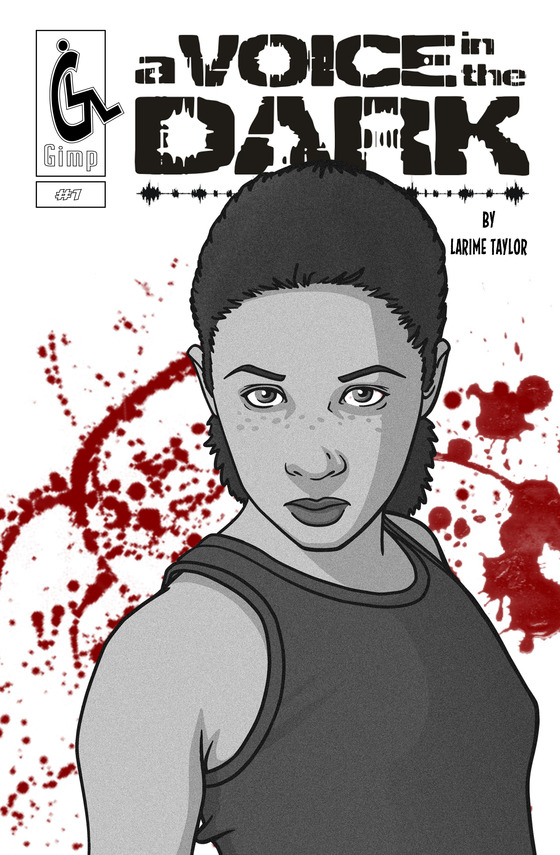
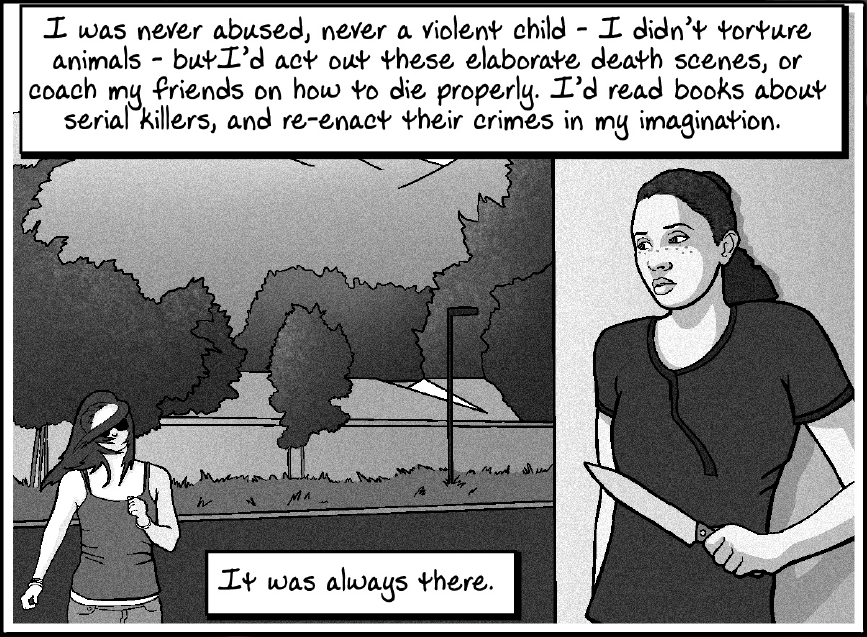
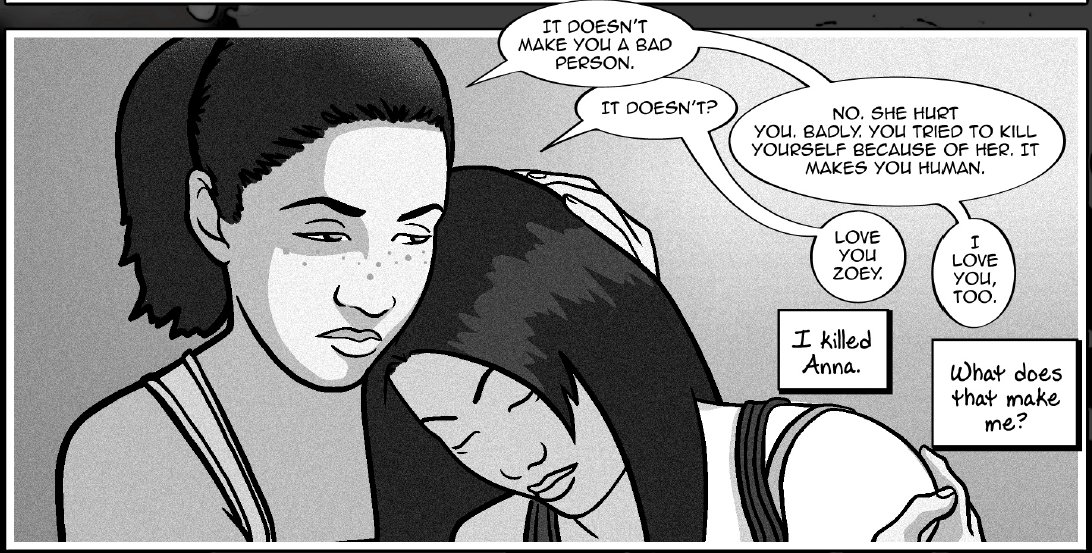
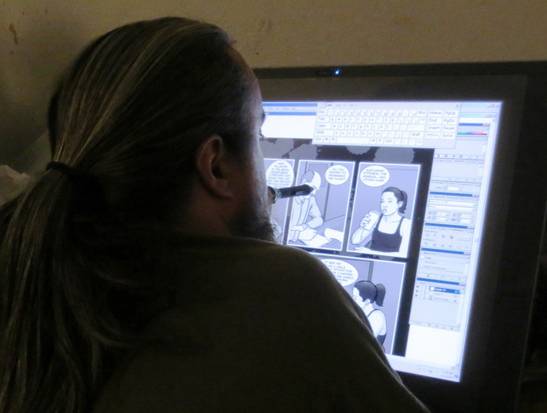

Thanks! This was a great interview to do, and I really enjoyed it!